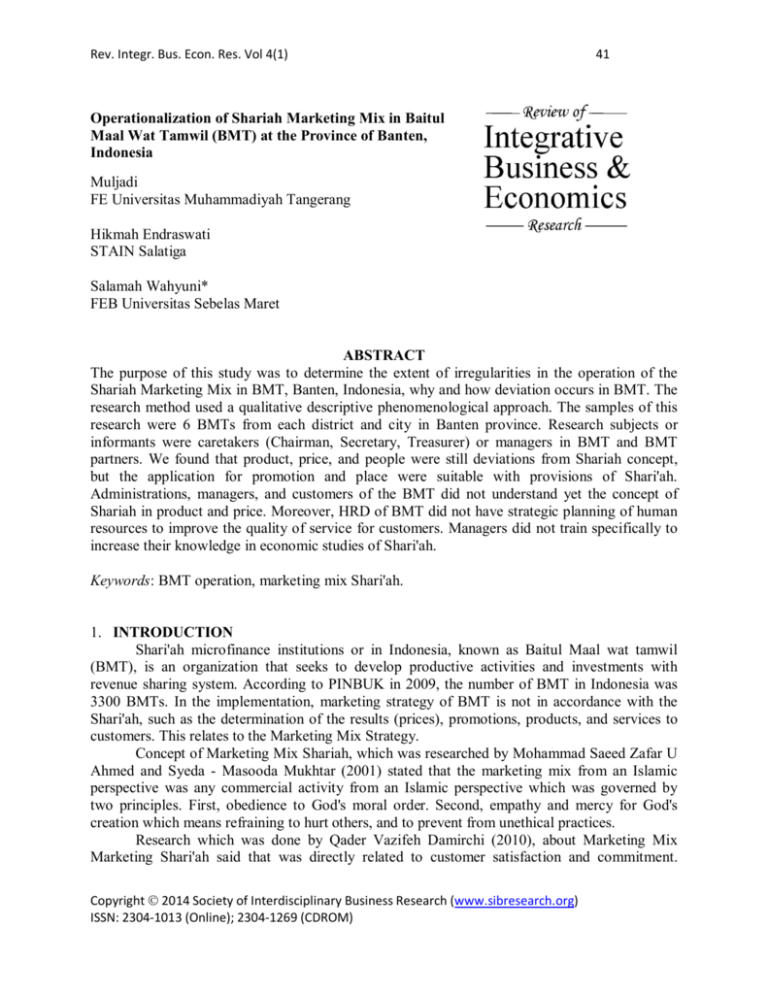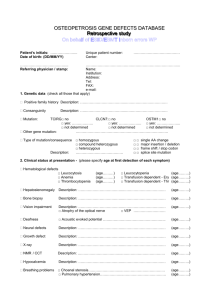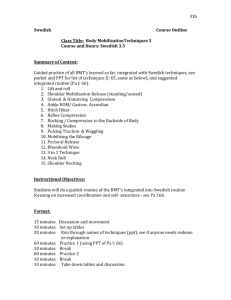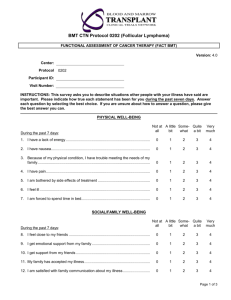Operationalization of Shariah Marketing Mix in Baitul Maal Wat Tamwil
advertisement

Rev. Integr. Bus. Econ. Res. Vol 4(1) 41 Operationalization of Shariah Marketing Mix in Baitul Maal Wat Tamwil (BMT) at the Province of Banten, Indonesia Muljadi FE Universitas Muhammadiyah Tangerang Hikmah Endraswati STAIN Salatiga Salamah Wahyuni* FEB Universitas Sebelas Maret ABSTRACT The purpose of this study was to determine the extent of irregularities in the operation of the Shariah Marketing Mix in BMT, Banten, Indonesia, why and how deviation occurs in BMT. The research method used a qualitative descriptive phenomenological approach. The samples of this research were 6 BMTs from each district and city in Banten province. Research subjects or informants were caretakers (Chairman, Secretary, Treasurer) or managers in BMT and BMT partners. We found that product, price, and people were still deviations from Shariah concept, but the application for promotion and place were suitable with provisions of Shari'ah. Administrations, managers, and customers of the BMT did not understand yet the concept of Shariah in product and price. Moreover, HRD of BMT did not have strategic planning of human resources to improve the quality of service for customers. Managers did not train specifically to increase their knowledge in economic studies of Shari'ah. Keywords: BMT operation, marketing mix Shari'ah. 1. INTRODUCTION Shari'ah microfinance institutions or in Indonesia, known as Baitul Maal wat tamwil (BMT), is an organization that seeks to develop productive activities and investments with revenue sharing system. According to PINBUK in 2009, the number of BMT in Indonesia was 3300 BMTs. In the implementation, marketing strategy of BMT is not in accordance with the Shari'ah, such as the determination of the results (prices), promotions, products, and services to customers. This relates to the Marketing Mix Strategy. Concept of Marketing Mix Shariah, which was researched by Mohammad Saeed Zafar U Ahmed and Syeda - Masooda Mukhtar (2001) stated that the marketing mix from an Islamic perspective was any commercial activity from an Islamic perspective which was governed by two principles. First, obedience to God's moral order. Second, empathy and mercy for God's creation which means refraining to hurt others, and to prevent from unethical practices. Research which was done by Qader Vazifeh Damirchi (2010), about Marketing Mix Marketing Shari'ah said that was directly related to customer satisfaction and commitment. Copyright 2014 Society of Interdisciplinary Business Research (www.sibresearch.org) ISSN: 2304-1013 (Online); 2304-1269 (CDROM) Rev. Integr. Bus. Econ. Res. Vol 4(1) 42 Principles of Islamic Marketing combined the concept of maximizing the value and the principle of justice. Metawa, SA and Al-Mossawi, M. (1998) studied Shari’ah Marketing Mix in Islamic Banking Financial Institutions. They focused about ethics and morals in providing services to clients, such as Dubai Islamic Bank, Bangladesh Islamic Bank, Bank Islam Malaysia Berhad, Bank Mandiri in Indonesia which has established a branch in each country. In this study, the researchers study about Baitul Maal Wat Tamwil (BMT), due to the pattern of business and social, with the foundation of Islamic law (shari'a). BMT has the advantage from that operationalization because of the concept of religious, but we should ensure that the power of religious is able to provide a convincing solution on the development of BMT. Actually, there are many BMTs in its operation does not use the concept of Shari'ah. The reasons shari'ah marketing mix research in BMT are, First, the study of shari’ah marketing mix in BMT has not been seriously studied. Second, the implementation of the shari’ah marketing mix has not optimally implemented. Third, an understanding of the shari’ah marketing mix has not been fully carried. 2. FOCUS OF RESEARCH This research focus is in the implementation of shari'ah Marketing Mix in BMT of Banten Province. 3. PROBLEMS FORMULATION The problems can be formulated as follow: a. How far the deviations of the operationalization Shari’ah marketing mix happen in BMT of Banten Province? b. Why do deviations of Shari'ah marketing mix (product, price, place, promotion, and people) happen in BMT of Banten Province? c. How do deviations of Shari'ah marketing mix (product, price, place, promotion, and people) happen in BMT of Banten Province? 4. LITERATURE REVIEW Baitul Maal literally means of the fund and Baitut tamwil means of home business. Baitul Maal based on the history was developed, from medieval times until the development of the prophet of Islam, where the Baitul Maal at the same time served to collect social funds, while Baitul Tamwil was a profit-motivated business institution (Ridwan, 2004). Baitul Maaal Wat Tamwil is operated by the principle of sharing, to grow and to develop micro and small businesses, in order to elevate and defend the dignity and interests of the poor (Amin Aziz, 2006). Euis Amalia (2008) said that BMT was designed as an economic institution which is the real conception and more focused on the community, poor and almost poor and near poor. BMTs attempt to help the development of micro and small enterprises, especially in capital. Qader Vazifeh Damirchi (2010) gave an overview of shari’ah marketing theory to analyze 5P (product, price, place, promotion, and people) with Islamic ethics. Copyright 2014 Society of Interdisciplinary Business Research (www.sibresearch.org) ISSN: 2304-1013 (Online); 2304-1269 (CDROM) Rev. Integr. Bus. Econ. Res. Vol 4(1) 43 Conceptual Framework People Islamic Marketing Mix Price Place Product Promotion Source: Damirchi 2003 5. METHOD The research method was descriptive qualitative method with a phenomenological approach. The datas of this research were primary data, secondary data, observation, interview and documentation. We analyzed with an interactive models : data reduction, data display and conclusion (Miles and Huberman, 1984). 6. EXPOSURE DATA AND RESEARCH FINDINGS From the observations, interviews and BMT contract documents, we analyze as follow : 1. Product a. The operationalization of Deposits at BMT is suitable with the shari’ah concept. Deposits Wadiah yad al-dhamanah in each BMT is accordance with the Shari'ah as a savings or deposit items must be returned in accordance with the agreements. Parties who receive money may use the deposit. The recipient will receive a deposit bonus. Mudaraba as a saving or deposit is a business cooperation contract between two parties where the first party (sahibul maal) provides the entire capital, while others become managers. Mudaraba business profits are divided according to the agreement set forth in the contract (Syafe'i Antonio, 2001). BMT may use the money saved in the form of financing for others customer, the agreement would be beneficial if there is profit sharing. b . Financing products consists of : 1 . Mudaraba , 2 . Musharaka 3 . Al - Ba'i (Murabaha , bai bittammal ajil), 4 . Qordul hasan. Deviations from Mudaraba financing occurs in BMT Al Qaryah and BMT Masjid Agung which has been decisive for the profit sharing. Profit sharing has been determined without explaining how the results ratio came from. Besides that there is promissory notes, whereas in mudharabah should be not a debt. Murabaha financing agreement in BMT Masjid Agung for the financing of the graduation is not appropriate. It should use Ijarah for the graduation financing (DSN fatwa on Murabaha). In BMT La - Syakka, there is financing which is called Musharaka mudharabah. It looks no clear agreement what to use musharaka or mudharabah (See the supplement II Fatwa DSN mudaraba/Qiradh). Because there is not musharaka Copyright 2014 Society of Interdisciplinary Business Research (www.sibresearch.org) ISSN: 2304-1013 (Online); 2304-1269 (CDROM) Rev. Integr. Bus. Econ. Res. Vol 4(1) 44 mudharabah financing in our regulation. There is only musharaka financing or mudharabah financing. There is deviation from sharia’h concept in aplication of murabaha financing in BMT Bina Tijaroh. There is no mention about BMT buy goods for customer in murabaha financing. (See supplement III of document 6). BMT only give money to buy goods by the customer (See supplement II MUI Fatwa DSN Murabaha). 2 . Price In determining the price, BMT use the principle of trading (with margin) and profit sharing. a. The pricing principle of trading (Murabahah and Bai Bitammal Ajil) BMT can choose customers of BMT as an agent to buy goods. BMT act as sellers of goods and sell goods to members/partners with a margin as an advantage from the purchase price. Almost all of the BMT, except for BMT Darul Falah, have good financing with murabaha contract. BMT provides funding to buy goods which are needed by customers, BMT determine additional price with customer approval and accordance with the standardization of prices in the market. In a murabaha contract, giving money directly to the customer violates the rules of sharia’h. The foundation of the regulation in Islam is used as a reference that allows buying and selling, but forbids Riba (Surat al Baqara 275) in determining the price of murabaha financing or Bai Bitammal Ajil financing. Understanding of Riba in BMT is still based on the interest rate. b. The pricing principles of cooperation profit sharing (Mudaraba and Musharaka) This principle is a system that includes procedures for the distribution of net income between the owners of the funds (shahibul Maal) to the fund manager (mudharib). The division 's results of operations may occur between BMT with its partners, the pricing form can use mudharabah or Musharaka. In determining the price of the contract at Musharaka is similar to Mudaraba. In Musharaka, profit-sharing distributes proportionally on the basis of all profits and no amount is specified in the initial set of a partner (Supplement II MUI Fatwa DSN Musharaka). BMT Bina Tijaroh in the writing of the contract to determine the price of the financing still use the credit, not financing. 3 . Promotion Promotion in BMTs uses brochures and study groups (religious group) as a means to introduce of BMT products. Promotion of BMT products is suitable with the shari’ah concept. 4 . Place Determination of place BMTs is still simple. The choice as the place is closed to the mosque, market, school or college and boarding school. The determination of places BMTs is not deviation from the shari’ah concept. 5 . People (HR) The administrators and managers do not understand about the science of Shari'ah, because HR of BMT does not meet training standards of PINBUK. In addition, the understanding the founder and administrator of BMT on the importance of qualified human resources have not been realized. All the BMT experience has the samething, namely the lack of honesty of employees, such as managers of BMT Masjid Agung said, Copyright 2014 Society of Interdisciplinary Business Research (www.sibresearch.org) ISSN: 2304-1013 (Online); 2304-1269 (CDROM) Rev. Integr. Bus. Econ. Res. Vol 4(1) 45 Mrs. Dewi Susanti, the proceeds should go to the BMT but in reality, the proceeds turns into the pockets of employees. Besides that, the understanding of shari’ah contracts is not maximized because of frequent employee turnover. CONCLUSIONS AND RECOMMENDATIONS A. Conclusions 1. There are already appropriate and there are any deviations from the provisions of Shari'ahin deposit product of BMT. In pricing and human resources management are still deviations from sharia’h. Only the promotion and determination of the place is already approach to the provisions of Shari'ah. 2. There are already appropriate and there are any deviations from the provisions of Shari'ahin deposit product of BMT. In pricing and human resources management are still deviations from sharia’h. Only the promotion and determination of the place is already approach to the provisions of Shari'ah. 3. Product and price of Sharia’h compliance is not understood by administrators, managers and customers. While for the people (HR), BMT does not prepare HR planning. Managers are not trained specifically to increase their knowledge in economic Shari'ah. B. Suggestions 1. Administrators, managers, and customers need a training and discussion forum to increase their knowledge so they understand each other in the concept of shari’ah marketing mix in the operation of BMT. 2. Educational institutions and scholars give the directions to the BMT to support the training of shari’ah concept and the government policies should support the development of BMT in Banten Province. References [1] Al-Qur”an terjemahan, 2008, Departemen Agama, Jakarta [2] Abul Hassan, Abdelkader Chachi and Salma Abdul Latiff, 2008, Islamic Marketing Ethics and Its Impact on Customer Satisfaction in the Islamic Banking Industry JKAU: Islamic Econ., Vol. 21 No. 1, pp: 27-46 [3] Ahmad, M. (1995) Business Ethics In Islam, IIIT, Islamabad. [4] Amalia, Euis. 2008. Reformasi Kebijakan Bagi Penguatan Peran Lembaga Keuangan Mikro dan Usaha Kecil Mikro di Indonesia, UIN Syarif Hidayatullah Jakarta [5] Amin, A. Riawan. 2006. The Celestial Management, Senayan Abadi Publising, Jakarta. [6] Amin, A, Riawan. 2010. Menggagas Manajemen Syariah, Salemba Empat, Jakarta [7] al-Nawawi, Imam (nd) “Riyadhus-Saleheen,” Trans., S. M. M. Abasi, IIPH, Riyadh. Copyright 2014 Society of Interdisciplinary Business Research (www.sibresearch.org) ISSN: 2304-1013 (Online); 2304-1269 (CDROM) Rev. Integr. Bus. Econ. Res. Vol 4(1) 46 [8] Antonio, M. Syafi’i. 2001. Bank Syari’ah Dari Teori ke Praktek, Tazkia Cendekia, Jakarta. [9] Antonio, M. Syafi’i. 2010. Ensiklopedia Leadership & Manajemen Muhammad SAW “The Super Leader Super Manager”, Tazkia Publishing, Jakarta [10] Asmi Nur Siwi Kusmiyati, 2007, Risiko Akad dalam Pembiayaan Murabahah pada BMT di Yogyakarta (dari Teori ke Terapan), La Riba Jurnal Ekonomi Islam , Vol 1 No. 1 [11] Aziz, M.Amin. 2006, Tata cara pendirian BMT, Pusat komunikasi Ekonomi Syari’ah, Jakarta [12] Aziz, M. Amin. 2007. Kegigihan sang Perintis, Pinbuk Press, Jakarta. [13] Aziz, M. Amin. 2008. The Power Al-Fatehah, Pinbuk Press , Jakarta. [14] Bogdan, Robert C. & Sari Knopp Biklen, 1982, Qualitative Research for Education: An. Introduction ti Theory and Methods, Boston: Allyn and bacon, Inc. [15] Constance, Elise Porter, Naveen Donthu. 2008. The link between Islamic banking and microfinancing, Management Science Vol. 54, Iss. 1; [16] Creswell, John W. 1994. Research Design: Qualitative and Quantitative Approaches. SAGE Publications. USA. [17] Drucker, Peter F.,1977. People and Performance, Harper college Press, p. 90 [18] Dahlan, Abdul Aziz et. al. 1999. Ensiklopedia Hukum Islam, cetaka ke II, ichtiar baru van havoe, Jakarta [19] E. Jerome McCarthy, with co-authors William D. Perreault, Jr. and Joseph P. Cannon, 1960, Basic Marketing. A Managerial Approach , now in its 17th edition [20] Fatwa-fatwa DSN MUI, 2000 [21] Fouad Abdullah al-Omar.1995. General , administrative and organizational Aspects, Institutional Framework of Zakah: Dimensions and Implications”seminar Procedings No. 23, IRTI- IDB. [22] Hermawan Kartajaya, sula. 2006.Syariah Marketing,Mizan Bandung [23] Irawan, Deni Sudrajat. 2008. Modul Bahan bacaan Pelatihan Dasar Pengelola BMT, Pinbuk Pusat, Jakarta [24] Kotler, Philip, and Keller, Kevin Lane 2009, Manajemen Pemasaran, Indonesia, Jilid I, Jakarta, Erlangga Copyright 2014 Society of Interdisciplinary Business Research (www.sibresearch.org) ISSN: 2304-1013 (Online); 2304-1269 (CDROM) Edisi Bahasa Rev. Integr. Bus. Econ. Res. Vol 4(1) 47 [25] Kotler, Philip, 1997, Manajemen Pemasaran, Analisis, Perencanaan, Implementasi,dan Kontrol, Edisi Bahasa Indonesia, Jilid I dan II, Jakarta, PT. Prenhallindo [26] Leonard Berry, A. Parasuraman, 1997, Listening to the Customer – The Concept of Service, Spring [27] Lupiyoadi, Rambat. 2001. Manajemen Pemasaran Jasa Teori dan Praktek, UI Press, Jakarta, [28] Muhadjir, Noeng. 1996. Metode Penelitian Kualitatif. Edisi III. Penerbit: Rake Sarasin, Yogyakarta. [29] M Akacem, Choice, Middletown. 2008. A political economy of the Middle East, Vol. 45, Iss. 9; pg. 1590, 1 pgs [30] Moleong, Lexy. 2002. Metodologi Penelitian Kualitatif. Edisi Revisi. Penerbit: PT Remaha Rosdakarya, Bandung. [31] Mackenzie M Festa, Alan J Wilson, Presha E Neidermeyer. 2010. Microlending: What Business Can Do, Journal of Applied Business Research. Laramie. [32] Masudul, Alam Choudhury. 2002. Economics. Bradford: Microenterprise development using Islamic financing and organizational instruments: Modality and practicum, International Journal of Social Economics, Bradford. [33] Masudul Alam Choudhury, Oman Mohammad Shahadat Hossain, Mohammad Solaiman. 2008. A well-being model of small-scale microenterprise development to alleviate poverty A case study of Bangladesh village, International Journal of Sociology and Social Policy, Vol. 28 No. 11/12, pp. 485-501, [34] Metawa, S.A. and Al-Mossawi, M. (1998) “Banking Behaviour of Islamic Bank Customers: Perspectives and Implications”, International Journal of Banking, 16(7): 299313. [35] Mohammad Saeed, Zafar U Ahmed, Syeda-Masooda Mukhtar. 2001. Internasional marketing ethics from an Islamic perspective: A value-maximization approach, Journal of Business Ethics, Dordrecht, Vol. 32, Iss. 2; Part 2. pg. 127, 16 pgs. [36] Mohammad Saeed, Zafar U Ahmed, Mukhtar Syeda-Masooda, Moin Siddiqi. 2006. Middle East. Jurnal Etika Bisnis, London. , Edisi 371; pg. 40, 5 pgs [37] Nasrin Shahinpoor, 2009, The link between Islamic banking and microfinancing, Department of Economics, Hanover College, Hanover, Indiana, USA Copyright 2014 Society of Interdisciplinary Business Research (www.sibresearch.org) ISSN: 2304-1013 (Online); 2304-1269 (CDROM) Rev. Integr. Bus. Econ. Res. Vol 4(1) 48 [38] Naser, K., Jamal, A. and Al-Khatib, K. (1999) “Islamic Banking: A Study of Customer Satisfaction and Preferences in Jordan”, International Journal of Bank Management, 17(3): 135-150. A [39] Nur Holis. 2008. Ringkasan Riset Kajian Terhadap Kepatuhan Syariah Dalam Praktik Pembiayaan di BMT Sleman, Yogyakarta, Jurnal Fenomena Volume 6-Nomor 1, Direktorat Penelitian dan Pengabdian Masyarakat (DPPM) Univervitas Islam Indonesia (UII) Yogyakarta [40] Prastowo, Andi. 2011. Metode Penelitian Kualitatif dalam Perspekktif Rancangan Penelitian, Ar-Ruzz Media, Yogyakarta [41] Saidi, Zaim, 2010, Tidak Syar’inya Bank Syari’ah di Indonesia, Yogyakarta, Delokomotif [42] Qader Vazifeh Damirchi,2003, A Guideline to Islamic Marketing Mix, Faculty Member Of Islamic Azad University – Parsabad Branch Barat Vazifeh Damirchi, Project manager Of Pars Sitting Systems [43] Ridwan, Muhammad. 2005. Manajemen Baitul Maal Wa Tamwil, UII Pess, Yogyakarta. [44] Rahardjo, M.Dawam.1999. Islam dan Transformasi Sosial Ekonomi, Pustaka Pelajar, Yogyakarta [45] Rusdy Hartungi. 2007.Understanding the success factors of micro-finance institution in a developing country, International Journal of Social Economics, Bradford.Vol. 34, Iss.6; pg. 388 [46] Rivai, Veithzal, Andria Permata. 2008. Islamic Financial Management, teori, konsep, dan aplikasi panduan praktis untuk lembaga keuangan, nasabah, praktisi dan mahasiswa, Rajawali Press, Jakarta [47] Sherin Galal Abdullah Mouawad. 2009. The development of Islamic finance: Egypt as a case study, Journal of Money Laundering Control, London,Vol. 12, Iss. 1; pg. 74 [48] Samy Nathan Garas, Chris Pierce. 2010. Shari’a supervision of Islamic financial institutions, Journal of Financial Regulation and Compliance, Vol. 18 No. 4, pp. 386-407 [49] Tyser, C.R., Demetriades, D.G. and Efendi, I.H. (1967) “A Complete Code on Islamic Civil Law,” (Translation from Turkish of Majallah-el Ahkam-i-Adliya, Majella, Lahore), New York: Law Publishing Company, NY. [50] Zallum, Abdul Qadim. 1993. Al-Amwal fi Daulah al-Khilafah. Beirut : Darul ‘Ilmi lil Malayin. Copyright 2014 Society of Interdisciplinary Business Research (www.sibresearch.org) ISSN: 2304-1013 (Online); 2304-1269 (CDROM)




